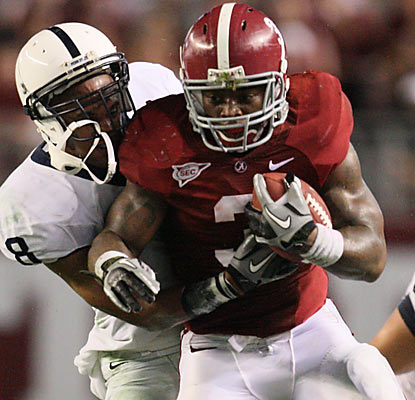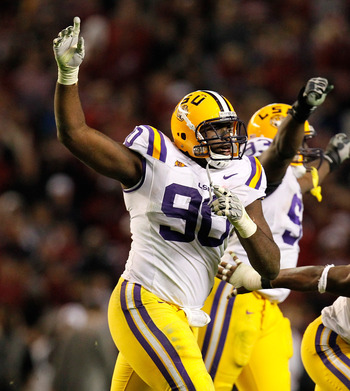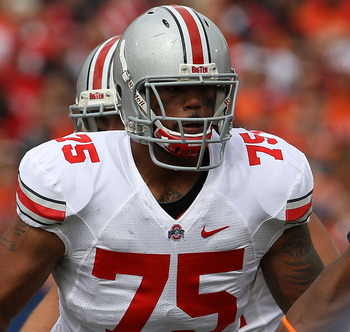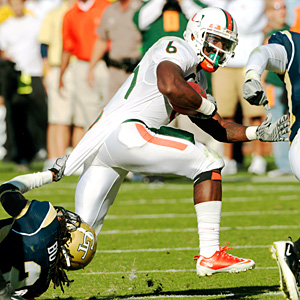
Kirk Cousins, seen here with a ball glued to his left wrist
One of the more intriguing prospects at the Senior Bowl this week is Michigan State quarterback Kirk Cousins. Draft Countown’s Shane Hallam reported yesterday that scouts from Seattle spoke to Cousins after yesterday’s opening practise and reports from the work out were fairly positive. Tony Pauline mentioned in his day one round-up, “Cousins showed a big league arm all day, powering the ball into targets and getting passes through the tight windows. He was relatively accurate for the most part and did a solid job.”
NFL Draft Scout’s Rob Rang was similarly positive, noting, “Cousins out-shined Wisconsin’s Russell Wilson and Boise State’s Kellen Moore by attacking all levels of a talented North defense. His experience in a pro-style offense was obvious as he made quick decisions, showed accuracy short, middle and deep and thread the needle through tight spaces. Whereas his teammates struggled to find a rhythm with their new receiving corps, Cousins was hitting on all cylinders, spreading the ball all over the field and hitting his backs, tight ends and receivers on a variety of routes.”
Scott Enyeart added to the intrigue yesterday, tweeting: “(Pete) Carroll has been evaluating Kirk Cousins since this summer at the Elite 11 camp in Malibu, where Kirk was a counselor.” Clearly this is a quarterback we need to monitor during the next few weeks and certainly he appears to be on Seattle’s radar.
My own view on Cousins is mixed. In many ways, I think he could be the fourth best quarterback in this class after Andrew Luck, Robert Griffin III and Brock Osweiler. Trying to explain why that might be the case is the hard part. Truly he is not a quarterback with a selection of defining, obvious talents. Really, he’s just pretty good across the board. He’s not physically outstanding, weighing just 209lbs at the combine in a modest 6-2 frame, but he has got a surprising punch to his throws and flashes natural talent as a passer, even if he occasionally trusts his arm a little too much. He’s adept at play-action and does a great job selling the fake, but he’s also shown a degree of comfort on bootleg’s and roll outs. Brilliant performances such as the Spartans 37-31 victory against unbeaten Wisconsin (Cousins: 22-31, 290 yards & 3TD’s) are off-set by the occasional head scratcher, such as the titanic struggle against Nebraska (11-27, 86 yards, 0TD’s and an interception). I contacted Michael Wilson from the ‘Little Brother’ Spartans Blog for his take on the team’s quarterback:
“He is a guy who just finds a way to win. Never been the biggest, fastest, strongest at any point in his career, but still made the most of everything he can do. He commands the offense well and is a good field general. I’ve heard his teammates say when he speaks in the huddle there is just a great level of certainty and confidence and trust. As for his skill set, nothing jumps out at you really. But he does just about everything well. His arm strength is really good (not elite, but above average), he can thread the needle well and does so with confidence (especially this season). He has decent mobility, but does not often pull the ball down and run. He has nice straight-line speed, isn’t going to cut and stiff arm or anything to break for huge yardage. I can recall a couple of 20-yard runs in his career.
“MSU runs a pro-style offense (and likes to run) with plenty of play action and snaps under center for Cousins, but this year opened it up a lot more. He does best on timing routes and makes very quick decisions. He will struggle, though, when protection breaks down quickly and nothing is open. That is when he struggles with mechanics and will throw off his back foot. Bottom line: As a fan, I will miss seeing him play for MSU. He is a winner. He is a guy who you take pride in playing for your team. And above all, you are really comfortable with him as a quarterback.”
One thing that stood out from Michael’s answer was the comment about throwing off the back foot, as it’s something I picked up on when noting Cousins during 2010 scouting. Last July I wrote: “It appears Cousins resorts to throwing off the back foot under pressure, which in turn also impacts his accuracy. When he feels the rush he sits back and spears the ball. Given his agility in the pocket you’d like to see a little less panic, stepping up into the pocket and driving the pass. I think he could be more composed which will ultimately lead to better technique. The one player he reminds me of in this regard is Kevin Kolb. Similar release, size and mobility. Neither are severely limited but don’t have the big-time physical skills. Given a nice collection of playmakers, both can succeed. Kolb was drafted with the 36th pick in 2007 and it wouldn’t surprise me come next April if we see Cousins go in a similar area.”
Although I never much rated Kolb, I was surprised how little success he had in Arizona throwing to Larry Fitzgerald. I watched the Cardinals three times this year and noticed a common trait within Kolb’s play – his tendency to check-down too often and avoid risk despite having an elite receiver who consistently bails out the quarterback. He’s always shown a tentative streak as evidenced in this edition of NFL Playbook from 2o10, but that’s where Cousins differs. Thankfully, he’s willing to take a few more risks and he’ll need to if he’s to succeed where Kolb has failed so far in fleeting starting opportunities. At the same time – as I’ll discuss in the tape breakdown later – there are certain throws Cousins needs to learn to avoid.
I watched and noted Cousins’ performance in week two of the 2011 season when MSU faced Florida Atlantic. “He drops back with a degree of comfort and in the shotgun and sets to throw with the ease of a seasoned pro. Cousins’ has a great grasp of play action and can both sell it and execute. When he’s forced to move around in the pocket he’s capable and he’ll extend plays while keeping his eyes downfield. Last season there were occasional errors trying to force the issue under pressure, but this was a cupcake game and he wasn’t tested. He isn’t a threat to break off runs and he’s exclusively elusive rather than a scrambler. I have noticed a tendency to panic on inside pressure, often throwing high to his right when rushed up the middle or taking an unnecessary sack. He’s much better against the edge rush, detecting the defender and making room to throw.”
It’s worth highlighting the intangible aspects before we get into the tape, because Cousins has battled to succeed during his career. Andy Staples at Sports Illustrated wrote an interesting piece discussing his battle to make the college ranks before eventually landing with the Spartans:
“Cousins quickly became the face of the Spartans. After sports information director John Lewandowski nominated Cousins to speak for the athletes at Big Ten media day in August, Cousins became the face of the Big Ten and — to some — the smiling face of what is right about college football in a time when scandals dominate the headlines. Cousins happily accepts the role. No amount of attention will change him. ‘”He doesn’t have to just be a great quarterback,” Dantonio said. “He’s going to be a great husband, a great father, a great community leader. The guy just sort of has it as a person.'”
If you want to see what all the fuss is about with regard to that Big Ten media day appearance, I’ve added the video of Cousins’ speech below. Clearly, we’re talking about a confident individual whose personality will appeal to the NFL. As Michael Wilson puts it: “That video epitomizes him — character through the roof. Intelligence through the roof — he plans on going to med school and won an $18K postgrad scholarship from the National Football Foundation. He won the Lowe’s Senior Class Award. He was a captain for three seasons at MSU — even before he was named the starter in his sophomore season. In a sentence: He is that guy you love representing your school/team.”
*********************************************************************************
Let’s get into the game tape. Below I’ve added Cousins’ performances against Indiana, Wisconsin and Ohio State from 2011. I’ll break down certain plays in note form following each video:
vs Indiana
0:01 – Good, sharp drop-back, identifies his target quickly and delivers the ball for a first down.
0:08– Effortless deep throw, precision delivery in behind a defensive back allowing the receiver to make a play in stride. Such a difficult throw to defend and the kind Seattle wants to use. Technique here is fundamentally sound, throws off the front foot and a nice spiral. Impressive.
0:24 – Another crisp drop-back, make a good read and delivers a nice pass to the right sideline.
0:45 – Excellent play fake executed to perfection and although the deep pass is relatively simple, he doesn’t throw it too conservatively allowing the receiver to continue moving and complete the score.
1:33– A lot of this touchdown is down to the work of Keshawn Martin (a senior receiver worth keeping an eye on) but Cousins does a great job identifying the coverage and purposely throwing high to make sure only the receiver can make a play. A necessary adjustment and good instincts and feel for the position.
2:16– This isn’t a good pass, thrown dangerously behind the receiver and without much velocity. That throw has to be arrowed to the left shoulder, closer to the sideline. It’s not a difficult throw that demands a high degree of accuracy. This was a missed opportunity and almost led to a turnover.
3:23– Evidence of struggles vs interior pressure. I sense Cousins just throws this away, or at least throws high to avoid the turnover and make it difficult for anyone to grab in the end zone. He actually had a checkdown to the left but never looks in that direction, focusing entirely on the end zone.
3:28 – Inaccurate throw to the end zone. Really needed to get more air on the ball and direct it to the far right corner. This is too short and makes the receiver stop to jump for the ball, when a slightly deeper throw would’ve caught him in stride.
vs Wisconsin
0:01 – Well executed play fake and a nice touch pass with a little more air to make the completion.
0:06 & 1:01– Evidence of greater confidence throwing over the middle. Cousins was a bit of a ‘sideline’ thrower in 2010, but these are the kind of throws he has to make at the next level.
0:21– Throws into a really tight window, but executes and hits the receiver on an inside slant.
0:44 – Cousins completely sells the toss, runs the bootleg to the right and hits the open receiver for a touchdown. It’s an easy throw, but only because of the perfect execution on the play fake. Nicely done.
1:22 – Similar throw to the play vs Indiana, the ball leaves the quarterbacks hands before the receiver cuts to the right – just excellent awareness and chemistry, plus good accuracy on the throw.
1:47 – I’m not entirely sure what to make of this throw. The read says triple coverage off the play action, but Cousins trusts his arm and makes the completion. It’s hard to be critical because it’s a big play, but quite risky at the same time. However, sometimes you have to back yourself and the receiver to make a play.
2:29 – The other side of the debate, as this time Cousins trusts his arm too much and gets picked off. That is NOT a pass that should be thrown. Cousins needs to identify the double coverage and the position of the safety who has leverage over the receiver. Get out of the call and live to fight another day. Bad decision.
2:47 – Better execution, putting enough height on the ball to make sure the defensive back wouldn’t get close to it, but also allowing the receiver to make a play.
4:41– Another bad read and should’ve been an interception. He needs to identify the position of the defender here to the left shoulder of the receiver, facing the quarterback. If he makes that throw, the defender is going to be able to make a play for the ball and cut off the route, while the receiver is always going to struggle to react.
vs Ohio State
0:24– Cousins gets a great block to keep this play alive, but what a throw to the back of the end zone for a touchdown. It’s a laser – superb arm strength, accuracy and he actually directs his receiver to the ball before throwing.
1:17 – Underrated throw that will impress pro-scouts. Flashes pro-drop back skills and the ability to look off to his right and snap back quickly to hit a short route to the right. Textbook quarterback play taking advantage of the deep coverage on 2nd and 17 to make a manageable third down.
1:41 – Needed to drill this pass to avoid it being cut off by a linebacker. Makes the completion and gets the first down.
2:45 & 5:44– Very fortunate to avoid turnovers here. A common occurrence appears to be the chances he takes on shorter routes that are almost cut off and returned for six. He needs to do a better job progressing from those reads and being a little more careful with the football. A serious concern, because it keeps flashing up on tape.
3:48– Just one of those things with the wet ball slipping out of his hands. Every quarterback will do this at some point in their career, but he should’ve covered the ball up when it was on the turf.
5:15 – Good initial footwork to extend the play but he has to hit the receiver in behind the defensive back. He snatched at the pass a little and rushed the throw, but he had the time and the positioning to make a higher, accurate delivery for a potential touchdown.
6:03– Superb throw under pressure (he was hit) and delivering the ball perfectly to the right sideline for a big gain. Excellent technique and placement to dissect the corner and safety – a difficult throw to make.
6:27 – Awful fade attempt basically tossed into the air for grabs and is deservedly intercepted. Cousins has to do better throwing the fade, it’s not good enough at the moment and needs work. Such a crucial throw at the next level that must be mastered.
7:38 – Great pump fake, but once the defensive back bites on the play he has to make that throw. Overshoots the intended receiver.
7:47– The worst throw and decision in any of the three games so far. Cousins just gets really sloppy here, dropping back and moving into space, before just aimlessly throwing the ball downfield straight to a defensive back. Why make that throw? Terrible decision and mistakes like that can be catastrophic in tight games.
Conclusion
Kirk Cousins has a lot of the natural qualities the Seahawks are looking for in a quarterback. They want to run the ball and use play action – a major strength for Cousins having played in MSU’s heavy ground attack. He’s mobile enough to run bootleg’s and roll outs, while he also has the kind of arm strength the front office have looked for so far in acquiring Tarvaris Jackson, Charlie Whitehurst and Josh Portis. He’s the kind of individual teams want fronting their offense and with his technical experience in something akin to a pro-style concept, Cousins could even have a fairly reasonable impact early in his career. There are also limitations and areas for drastic improvement, particularly with decision making on shorter routes, learning to cope with inside pressure and trying to avoid throwing off the back-foot too often.
The Seahawks seem unlikely to get their fix at quarterback in round one, but it’s almost certain they’ll eventually draft at least one player at the position in April. Cousins is being slightly underrated with some considering him merely as a late round option, but the Seahawks seemingly have enough interest and could take a look as early as round two – particularly if they are able to address a key defensive need in round one.




































